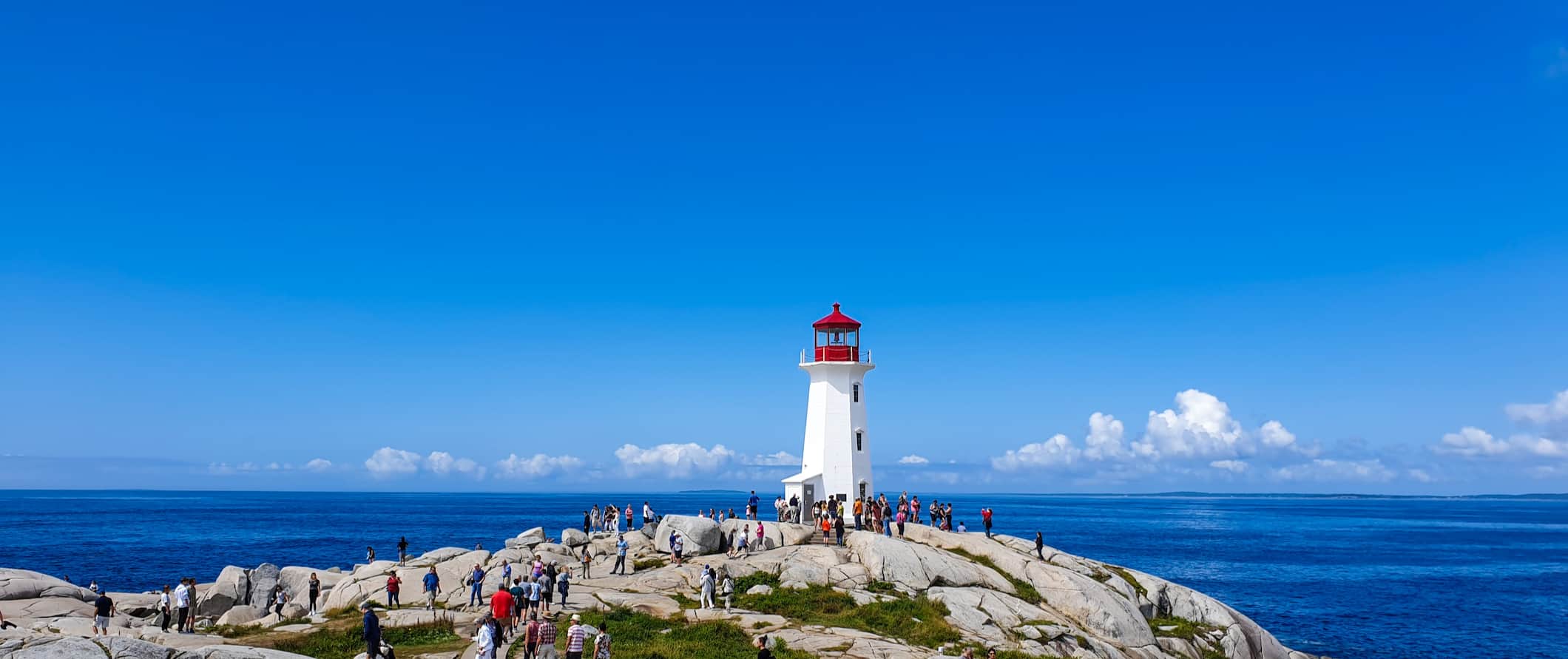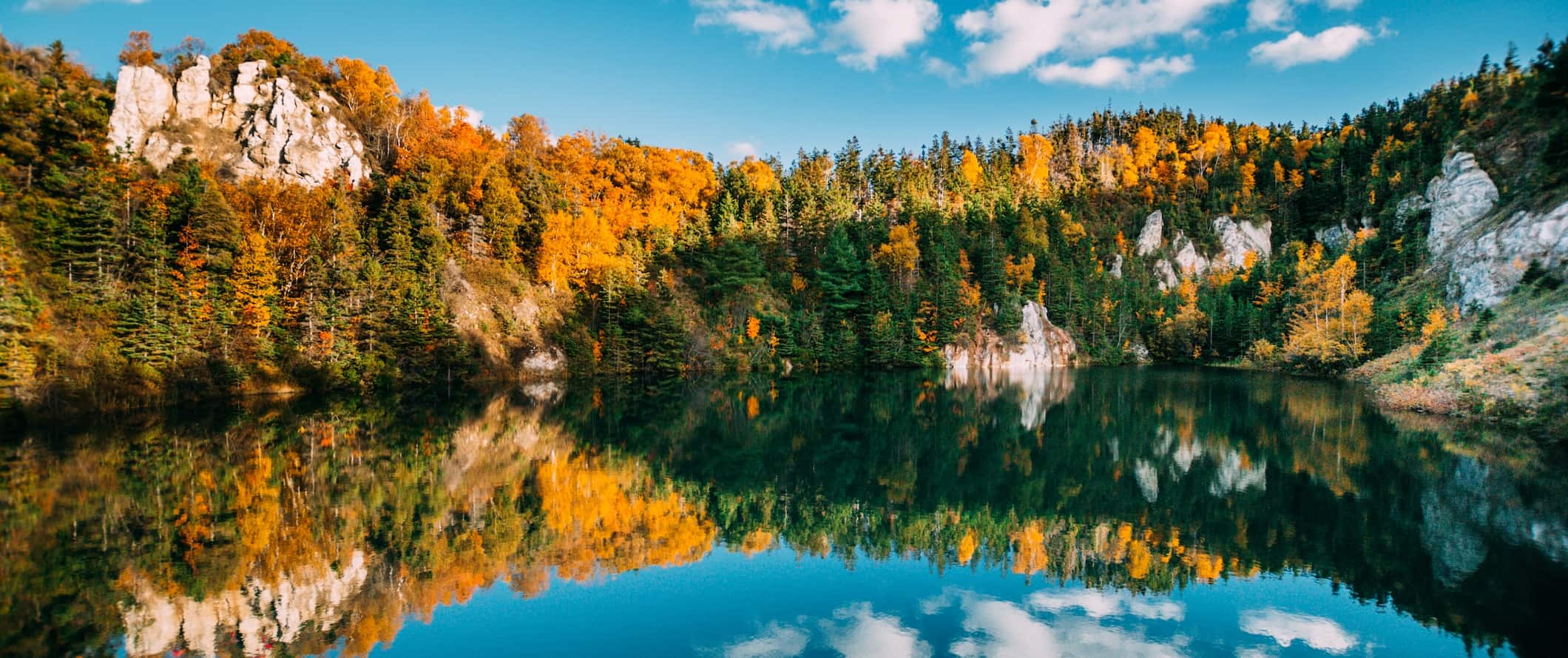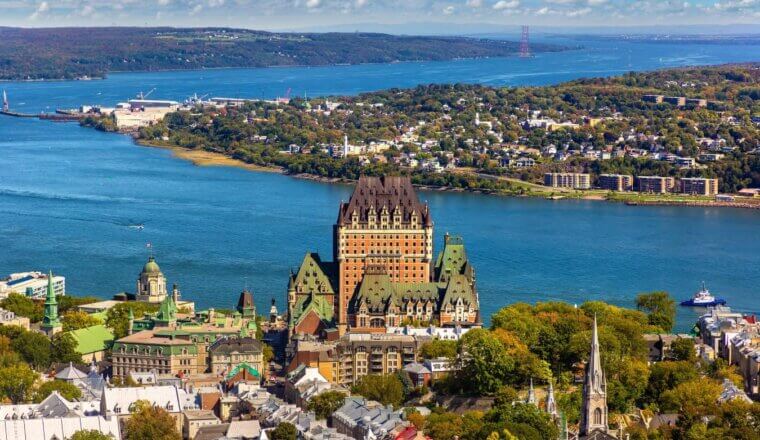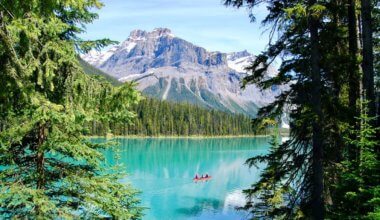Nova Scotians like to boast that their province is the friendliest place in Canada. They might just be right because you’ll feel welcome the minute you step foot in this gorgeous Maritime province.
That welcoming atmosphere — combined with over 100 beaches, picturesque lighthouses, fresh seafood, and endless rugged coastline — makes visiting Nova Scotia an exciting (and underrated) destination in Eastern Canada.
Outside the capital city of Halifax, Nova Scotia is dotted with tiny fishing villages and coastal towns. Drive further north, and you’ll hit scenic Cape Breton Island which comes alive with vivid fall foliage each year along its Cabot Trail. In short, Nova Scotia is a province perfect for road trips.
Another bonus: Nova Scotia doesn’t see nearly as many tourists as the country’s larger cities, making it a somewhat off-the-beaten-trail destination that’s much more affordable than many of the more popular cities in Canada.
This travel guide to Nova Scotia can help you plan your trip, save money, and make the most of your visit to this beautiful east coast province!
Table of Contents
Top 5 Things to See and Do in Nova Scotia
1. Hike the Skyline Trail
The Skyline Trail is easily the most popular hike in Cape Breton Highlands National Park. It stretches 6.5 kilometers (4 miles) through thick forest and then along the coast to reach a viewing platform overlooking the ocean. It’s a breathtaking walk on which you might even encounter moose. The hike is suitable for all levels and takes between 1.5-3 hours. Make sure to bring your own water, good shoes, and clothing layers as the weather can change quickly. The most popular time to visit is July, August, and September but many people come to see the autumn leaves change in October. Park admission is 8.50 CAD.
2. Tour the Alexander Keith’s Brewery
Alexander Keith is a legend in Nova Scotia. He opened his brewery in 1820, became mayor of Halifax, and was so wildly popular that Halifax throws a massive birthday party for him on the waterfront every October. Today, the 200-year-old brewery is one of the oldest in North America. Take a tour of the Halifax brewery to learn more and sample some of the limited edition beers at “Stag’s Head” pub at the end of the tour. Tours are 29.95 CAD.
3. Hang out in Halifax
Halifax is Nova Scotia’s cool capital city. It’s home to half a dozen universities so it has a lively nightlife, a thriving music scene, and countless trendy restaurants and craft breweries. Stroll the waterfront boardwalk, grab a lobster roll, and spend the evening at a local pub. Take the ferry over to Dartmouth across the harbor, known as ‘Halifax’s Brooklyn’ and check out the live music at New Scotland Brewing Company. The city has a youthful, arty vibe and is worth visiting for a couple of days.
4. Visit Peggy’s Cove Lighthouse
There are some 170 lighthouses in Nova Scotia, but Peggy’s Cove Lighthouse is the most famous. Once you see it, you’ll understand why it’s one of the most photographed lighthouses in the world. It’s a quintessential red-topped lighthouse standing on a rocky shore overlooking the Atlantic. Walk around and enjoy the ocean views and snap some photos. Beware: rogue waves are common, even on calm days. It’s possible to reach the lighthouse via bus and taxi but it is much easier by car.
5. Drive the Cabot Trail
The Cabot Trail on Cape Breton Island is one of North America’s most spectacular ocean drives, following a 298-kilometer (185-mile) ribbon of road that loops around the island and passes through Cape Breton Highlands National Park. The drive passes through several small coastal villages where you can feast on delicious fresh seafood. There are many short hikes and clifftop boardwalks with stunning scenic viewpoints as well. Some of the top viewpoints on the trail to see are Cape Smokey, MacKenzie Mountain, Cap Rouge, Lakes Head, and North Mountain. You can also download an audio guide for the trail if you want to learn more while you explore.
Other Things to See and Do in Nova Scotia
1. Go tidal bore rafting in Shubenacadie
The Shubenacadie River’s rapids in the Bay of Fundy are powered by the highest tides in the world. One minute you’re floating down a peaceful river keeping an eye out for bald eagles and other wildlife and the next minute the river turns into a raging, foaming mass of rapids. When the tide changes twice a day, the tidal bore temporarily reverses the flow of the river, resulting in this wild river ride. A four-hour tour includes the guided rafting excursion, safety flotation gear, extra mud sliding on request (yes!), and post-rafting showers for when you need to clean up. Make sure to bring an extra clean change of clothes as well as a towel. A four-hour rafting trip starts at 95 CAD.
2. Go whale watching
In the summer and fall, 12 species of whales visit the waters around Nova Scotia, including pilot whales, minke whales, giant humpbacks, and the endangered North Atlantic right whale. There are tons of whale-watching tours to choose from in the area, with most operating outside of Halifax. Mariner Cruises takes you out for a 2.5-hour boating tour for 50 CAD departing from Westport on Brier Island, while larger groups like Lunenburg Whale Watching Tours start at 70 CAD.
3. Enjoy summer on the water
Summer is short in Nova Scotia, so when the weather is nice and the sun comes out, Nova Scotians hit the water to go sailing, kayaking, paddle boarding, and canoeing. Surfing is also big here, with Lawrencetown Beach being one of the more popular areas to find the biggest waves. Go swimming at Melmerby Beach or take a kayak around Kejimkujik National Park. Kayak rentals cost around 25 CAD for two hours or 32 CAD for the entire day.
4. Wander the Annapolis Royal Historic Gardens
Spanning 17 acres of greenery, these historical gardens overlook a tidal river valley and include an enormous rose collection (best seen in July) as well as an 18th-century Governor’s Garden and a 19th-century Victorian Garden. You can check out the reconstructed 1671 Acadian House or grab a coffee and light lunch at The Elm Tree Café (seasonal). It’s 16 CAD to visit except November to April when there is only a suggested donation of 5 CAD as the Gardens are not maintained during the winter months.
5. Visit the Alexander Graham Bell Historic Site
This museum in Cape Breton is host to a rich collection of artifacts and documents chronicling the life and career of Bell, the inventor of the telephone. The collection was accumulated by his family during their time here in Baddeck, Cape Breton. In the parlor, you can see Bell’s personal effects, like his favorite jacket, notebook, and walking stick. You can also take a behind-the-scenes “White Glove Tour” of the artifact storage facilities. The site is open May-October and admission is 8.50 CAD (13 CAD for the white glove tour).
6. Explore the Highland Village Museum
Over the centuries, the Canadian Maritimes have been heavily influenced by Scottish and Irish immigration. This outdoor pioneer museum and Gaelic culture experience highlights that history. The 43-acre site overlooking Bras d’Or Lake includes historic buildings like three frame houses, a mill, and a forge. You can take part in a traditional céilidh dance, hear Gaelic singing, and even practice a little of the language yourself. It’s open from June to October and costs 11 CAD.
7. Tour the Maritime Museum of the Atlantic
This museum depicts Nova Scotia’s maritime history with exhibits on boatbuilding, World War II convoys, the Titanic, and the Halifax Explosion (a huge disaster that happened in 1917, when two ships carrying ammunition ran into each other and destroyed much of the city). It’s a very comprehensive overview of the region’s history. Admission is 5.15 CAD from November-April and 9.55 CAD from May-October.
8. Visit nearby New Brunswick or Prince Edward Island
These two provinces are close to Nova Scotia and can be visited as day trips (or multi-day trips) if you have your own vehicle. Don’t miss New Brunswick’s Fundy National Park to see the world’s highest tides. In P.E.I., you can soak up some tranquility on the sea (and eat lots of seafood) and visit the Anne of Green Gables house.
9. Explore Lunenburg
Lunenburg is one of the most colorful towns you’ll ever come across. With its narrow streets and colonial 18th- and 19th-century buildings painted in bright hues of pinks, oranges, and greens, you’ll feel like you’ve stepped back into the past. There are still tall ships in the harbor and even an operational blacksmith hammering away on the waterfront. The harbor is home to the famous Bluenose II, a replica schooner of the original Bluenose boat that’s featured on the Canadian dime (ten-cent coin). The Bluenose was a famous fishing/racing schooner that went undefeated in her 18-year run and is an iconic part of Canadian history.
10. Tour the Canadian Museum of Immigration at Pier 21
If there’s just one museum you visit in Halifax, make it this one. Pier 21 was the immigration point for one million newcomers to Canada between 1928 and 1971. You’ll learn about 400 years of Canadian immigration history through first-person stories, archival photos, artifacts (including trunks and personal treasures), and digital documentation. Exhibits are incredibly interactive and you can even research your family’s pre-1935 immigration records from all ports of entry in North America. Admission is 15.50 CAD.
11. Relax in Kejimkujik National Park
For a taste of Maritime nature, come to this national park to paddle, hike, camp, and relax. Here you’ll find ancient rock carvings (petroglyphs), canoe routes, and coastal wilderness punctuated with sandy beaches and wildlife. To learn more about the Mi’kmaq people who traditionally have called the region home, join a storytelling session, take a guided petroglyph tour, or participate in a canoe-building workshop. Admission to the park is 6.25 CAD.
For more information on other destinations in Canada, check out these guides:
Nova Scotia Travel Costs
Hostel prices – Hostels are virtually non-existent in Nova Scotia. The only exception is Halifax. A bed in a 4-6-person dorm costs 30-35 CAD per night. A private room costs about 78-90 CAD per night. Expect basic amenities like free Wi-Fi and self-catering facilities.
For those traveling with a tent, camping is available around the province starting at 27 CAD per night. This gets you a basic plot without electricity for two people.
Budget hotel prices – Budget hotels start around 105 CAD per night for a place outside of Halifax. Within Halifax, most budget hotels start at around 130 CAD per night. Expect basic amenities like free Wi-Fi, TV, AC, and a coffee/tea maker. Prices are lower during the off-season.
Airbnb is available all around Nova Scotia. Private rooms start around 50-75 CAD per night, though they average double (or even triple) that price. An entire home/apartment costs around 100 CAD per night, though they average closer to 160 CAD (200 CAD in Halifax). Book early to find the best deals.
Food -In Nova Scotia, seafood is king. Be sure to try scallops and oysters, wild blueberries, lobster, and donair (thinly sliced beef in a pita with a sauce that’s similar to kebab; it’s the official food of Halifax). Also, be sure to sample more general Canadian staples like poutine (fries with gravy and cheese curds), beaver tails (fried dough with maple syrup), Canadian bacon, and the oddly tasty ketchup chips.
You can find cheap street food eats like donair for around 7 CAD (go to Johnny K’s), or a small pizza on Halifax’s “Pizza Corner” (an intersection at Blowers Street and Grafton Street full of pizza places) for less than 10 CAD.
A fast food combo meal (think McDonald’s) costs around 12 CAD. A lobster roll at an inexpensive restaurant is about 20 CAD, while lobster poutine is closer to 18 CAD. A bowl of pasta (such as scallop carbonara) costs around 20 CAD. A beer to go with it is about 7 CAD while a glass of wine starts at 9 CAD.
A meal at a higher-end restaurant costs about 40 CAD for a steak or duck entree without a drink, while lobster is closer to 55 CAD.
If you cook for yourself, expect to spend 50-65 CAD on groceries per week. This gets you basic staples like rice, pasta, seasonal produce, and some meat or fish.
Some recommended places to eat include No. 9 Coffee Bar (Lunenburg), The Barn Coffee & Social House (Mahone Bay), The Economy Shoe Shop (Halifax), McKelvie’s Restaurant (Halifax), and The Wooden Monkey (Halifax).
Backpacking Nova Scotia Suggested Budgets
If you’re backpacking Nova Scotia, expect to spend about 70 CAD per day. This assumes you’re staying in a hostel, cooking all your meals, limiting your drinking, taking public transit to get around, and doing mostly free activities like swimming and hiking. If you plan on drinking, add another 10-15 CAD to your daily budget.
On a mid-range budget of 180 CAD per day, you can stay in a private Airbnb, eat out for a few meals, enjoy a couple of drinks, rent a car to get around, and do more paid activities like rent a kayak, visit museums, and day trips to a nearby province.
On a “luxury” budget of 280 CAD per day or more, you can stay in a hotel, rent a car, drink more, eat out for most meals, and do whatever tours and activities you want. This is just the ground floor for luxury though. The sky is the limit!
Nova Scotia Travel Guide: Money-Saving Tips
Nova Scotia can be an affordable destination if you budget properly. It gets more expensive during peak summer season and early fall (everyone comes to see the leaves change color). Here are some of my ways to save money in Nova Scotia during your visit:
- Stay with a local – If you plan ahead, you can usually find a Couchsurfing host in Halifax. This way, you not only have a free place to stay, but you’ll have a local host that can share their insider tips and advice.
- Take a free walking tour – Walking tours are a great way to get familiar with a city and its culture. Halifax Free Walking Tours offers daily informative walking tours in the summer. In the off-season, tours are available by request. Just be sure to tip your guide at the end!
- Look for free events – Many of Nova Scotia’s events and festivals are free, including Halifax’s Busker Festival in July. Many towns (like Pictou) also have free summer concerts in public spaces. Check the Tourism Nova Scotia website for more info!
- Go camping – If you want to camp, use novascotia.goingtocamp.com to find available campsites around the province. A two-person site costs around 27-35 CAD.
- Look for the happy hours – The Ultimate Happy Hours website lists all the happy hour drink and food specials around Halifax. They update with new info frequently!
- Get the Museum Pass – If you plan on visiting lots of museums, the Nova Scotia Museum Pass lets you pay one price to access any of the province’s museum sites. It’s valid for 12 months and costs 47 CAD.
- Bring a water bottle – The tap water here is safe to drink so bring a reusable water bottle to save money. LifeStraw makes a reusable bottle with a built-in filter to ensure your water is always safe and clean.
Where to Stay in Nova Scotia
Nova Scotia doesn’t have many hostels and most of the existing ones are in Halifax. Here are my suggested places to stay:
How to Get Around Nova Scotia
Public transportation – Halifax is the only major urban center in Nova Scotia and locals depend on a public bus system to get around. Halifax’s public buses can take you all around the inner city and into the suburbs, but the downtown area is very walkable. Fares are 2.75 CAD.
You can take the MetroX bus from the airport to downtown St. John’s for 4.25 CAD (exact change required). There’s also a ferry connecting downtown Halifax to Dartmouth for 2.75 CAD.
Bus – Taking the bus is the best way to get around Nova Scotia if you don’t have a car. Maritime Bus connects most towns in the province. A two-hour trip from Halifax to Lunenburg is 26 CAD, while Halifax to Mahone Bay takes an hour and costs 20.25 CAD. Halifax to Sydney (Cape Breton) costs 72 CAD and takes 6 hours.
To find bus routes and prices, use BusBud.
Taxi – Taxis are not cheap here. Their base rate is 3.75 CAD, and it’s an additional 1.70 CAD per kilometer afterward. Prices add up fast so I’d avoid them if you can.
Ridesharing – Uber is available in Halifax, but the city is easily walkable so I’d skip the ridesharing if you can.
Car Rental – Car rentals can be found for as little as 30 CAD per day for a multi-day rental. If you want to take advantage of all that Nova Scotia has to offer, this is your best option. For the best car rental prices, use Discover Cars.
Hitchhiking – Hitchhiking isn’t super common here, but if you have the time and don’t mind waiting then you can definitely give it a go. For more information and advice, check out Hitchwiki.
When to Go to Nova Scotia
Nova Scotia is at its busiest in the summer, with the best weather occurring between June and August. Temperatures often exceed 25°C (78°F). Keep in mind that accommodation prices are higher during this time, but tourist attractions are never overly crowded compared to elsewhere in Canada.
Both early fall and late spring are also excellent times to visit. The weather is warm, you can do all the outdoor exploration you want, and the tourist season isn’t in full swing. This is the best time to drive Cape Breton’s Cabot Trail. The fall colors are particularly pretty.
Winters in Nova Scotia are cold and wet, with temperatures ranging between from -17-0°C (0-32°F) from December to March. If you come during this time, be prepared for all weather types and dress in layers because it is cold. Keep in mind that many businesses shut down for the winter (mostly outside of Halifax). In short, I’d avoid a winter visit unless you’re here for winter sports and activities.
How to Stay Safe in Nova Scotia
You don’t have to worry much about crime in Nova Scotia — it’s incredibly safe to visit. Your greatest risk is petty crime like pickpocketing, but even that is super rare. Overall, I really wouldn’t worry about crime here. Getting hurt hiking is more likely to happen than any crime!
Like much of rural Canada, Nova Scotia has ticks that carry Lyme Disease. If you’re hiking, try to wear long sleeves or pants, or stick to well-trodden trails. Check yourself for ticks after spending time in nature.
Solo female travelers should generally feel safe here. However, the standard precautions you take anywhere apply (never leave your drink unattended at the bar, never walk home alone intoxicated, etc.). For more information, check out one of the many solo female travel blogs in the city.
If you’re visiting in the winter, make sure you keep an eye on the weather — especially if you’re driving a car. Road conditions can change rapidly.
Hurricanes can occasionally make it up to the Maritimes, so keep an eye on them if you’re visiting during hurricane season (June-November).
If you experience an emergency, dial 911 for assistance.
When in doubt, always trust your instincts. If a taxi driver seems shady, get out. If your hotel or accommodation is seedier than you thought, go somewhere else. Make copies of your personal documents, including your passport and ID, in case of an emergency.
The most important piece of advice I can offer is to purchase good travel insurance. Travel insurance will protect you against illness, injury, theft, and cancellations. It’s comprehensive protection in case anything goes wrong. I never go on a trip without it as I’ve had to use it many times in the past.
Nova Scotia Travel Guide: The Best Booking Resources
These are my favorite companies to use when I travel. They consistently have the best deals, offer world-class customer service and great value, and overall, are better than their competitors. They are the companies I use the most and are always the starting point in my search for travel deals.
- Skyscanner – Skyscanner is my favorite flight search engine. They search small websites and budget airlines that larger search sites tend to miss. They are hands down the number one place to start.
- Hostelworld – This is the best hostel accommodation site out there with the largest inventory, best search interface, and widest availability.
- Booking.com – The best all around booking site that constantly provides the cheapest and lowest rates. They have the widest selection of budget accommodation. In all my tests, they’ve always had the cheapest rates out of all the booking websites.
- Get Your Guide – Get Your Guide is a huge online marketplace for tours and excursions. They have tons of tour options available in cities all around the world, including everything from cooking classes, walking tours, street art lessons, and more!
- SafetyWing – Safety Wing offers convenient and affordable plans tailored to digital nomads and long-term travelers. They have cheap monthly plans, great customer service, and an easy-to-use claims process that makes it perfect for those on the road.
- LifeStraw – My go-to company for reusable water bottles with built-in filters so you can ensure your drinking water is always clean and safe.
- Unbound Merino – They make lightweight, durable, easy-to-clean travel clothing.
- Top Travel Credit Cards – Points are the best way to cut down travel expenses. Here’s my favorite point earning credit cards so you can get free travel!
Nova Scotia Travel Guide: Related Articles
Want more info? Check out all the articles I’ve written on backpacking/traveling Canada and continue planning your trip:
Where to Stay in Quebec City: The Best Neighborhoods for Your Visit
Where to Stay in Vancouver: The Best Neighborhoods for Your Visit
Where to Stay in Toronto: The Best Neighborhoods for Your Visit
Canada Road Trip: A One Month Suggested Itinerary
How to Road Trip the Yukon on a Budget
How to See Alberta: A 10-Day Suggested Driving Itinerary









